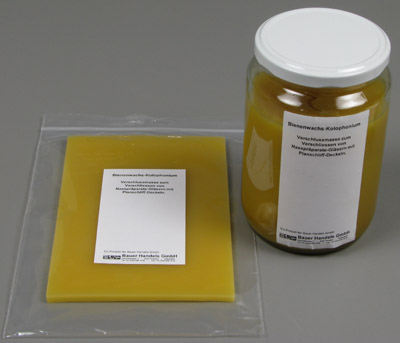
Liquid Preparations
Beeswax-colophony mixture
Sealing compound for sealing wet preparation jars with plane ground lids.
This gas-tight, formaldehyde- and alcohol-resistant sealing compound has long been used successfully in many museums and institutes to seal jars of wet specimens. Applying the heated glass lid creates a vacuum in the glass container. In long-term tests conducted by Klaus Wechsler (Bremen), a beeswax-colophony mixture proved to be the best material in a comparison of many sealing compounds. Furthermore, many preparations that have been tight for over 100 years prove that this is one of the few sealing compounds that really work.
Processing:
The beeswax-colophony mixture is heated to approx. 85 - 90° C on an adjustable hotplate or in a heated water bath. Using a natural bristle brush, the liquid sealing compound is brushed onto the absolutely flat and clean rim of the glass. The glass lid, heated to 130 - 160°C in the heating oven depending on its thickness (thinner lids are heated to a higher temperature because of their lower storage capacity), is carefully placed on the glass with large tweezers insulated at the front with paper masking tape. The hot lid melts the wax and heats the air at the top of the jar. By moving the lid sideways, the expanding air is released. It is important to do this in different directions so that the lid cools evenly. Through the lid, it is easy to observe what is happening. If air finds its way from the inside to the outside through the sealing compound, it may be necessary to vent again. If no more air escapes, the lid is weighted down with 1 to 2 light weights (e.g. large nuts insulated with cardboard). If air from the outside finds its way in, liquid sealing compound can be applied from the outside with a brush. This operation requires practice and experience. If the sealing is not successful, open the jar again and repeat the whole procedure. To ensure that the jar is tight, a seal at least 4 mm wide is required all around. This can be easily checked visually from above through the lid.
For further reading, see for example the report in the Preparator Issue 2000, Volume 4, pages 171 to 186.
In the beeswax-colophony mixture, crystalline precipitation of rosin may occur in the melt (over a long time). If this is the case, the mass should no longer be used. The delivery unit of 100g is sufficient to seal 50 to 150 jars.
Note:
Beeswax rosin mixture can also be used for reversible modeling work in the restoration of specimens or for modeling small models.
Processing:
The beeswax-colophony mixture is heated to approx. 85 - 90° C on an adjustable hotplate or in a heated water bath. Using a natural bristle brush, the liquid sealing compound is brushed onto the absolutely flat and clean rim of the glass. The glass lid, heated to 130 - 160°C in the heating oven depending on its thickness (thinner lids are heated to a higher temperature because of their lower storage capacity), is carefully placed on the glass with large tweezers insulated at the front with paper masking tape. The hot lid melts the wax and heats the air at the top of the jar. By moving the lid sideways, the expanding air is released. It is important to do this in different directions so that the lid cools evenly. Through the lid, it is easy to observe what is happening. If air finds its way from the inside to the outside through the sealing compound, it may be necessary to vent again. If no more air escapes, the lid is weighted down with 1 to 2 light weights (e.g. large nuts insulated with cardboard). If air from the outside finds its way in, liquid sealing compound can be applied from the outside with a brush. This operation requires practice and experience. If the sealing is not successful, open the jar again and repeat the whole procedure. To ensure that the jar is tight, a seal at least 4 mm wide is required all around. This can be easily checked visually from above through the lid.
For further reading, see for example the report in the Preparator Issue 2000, Volume 4, pages 171 to 186.
In the beeswax-colophony mixture, crystalline precipitation of rosin may occur in the melt (over a long time). If this is the case, the mass should no longer be used. The delivery unit of 100g is sufficient to seal 50 to 150 jars.
Note:
Beeswax rosin mixture can also be used for reversible modeling work in the restoration of specimens or for modeling small models.
All prices plus VAT and shipping costs











